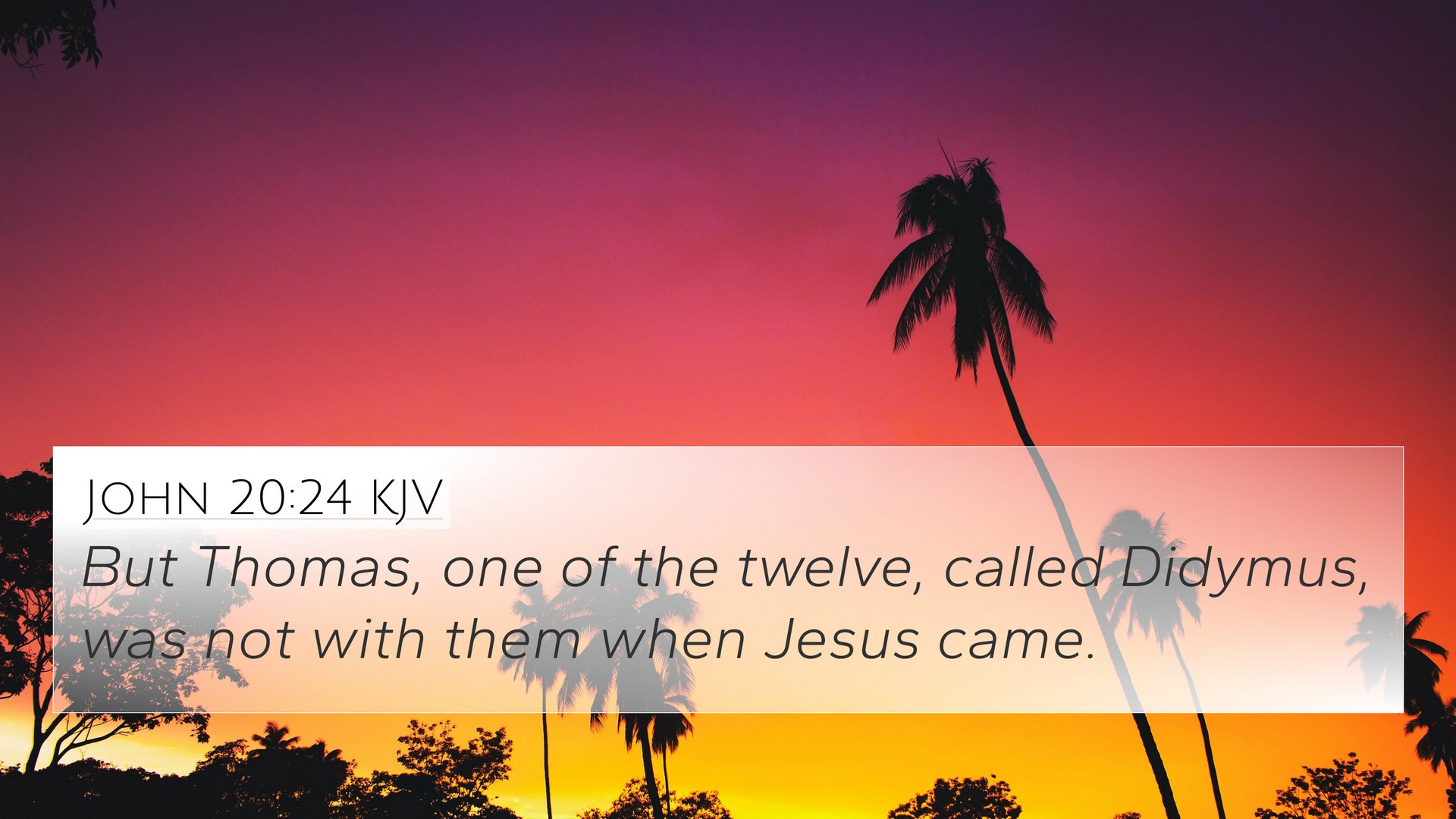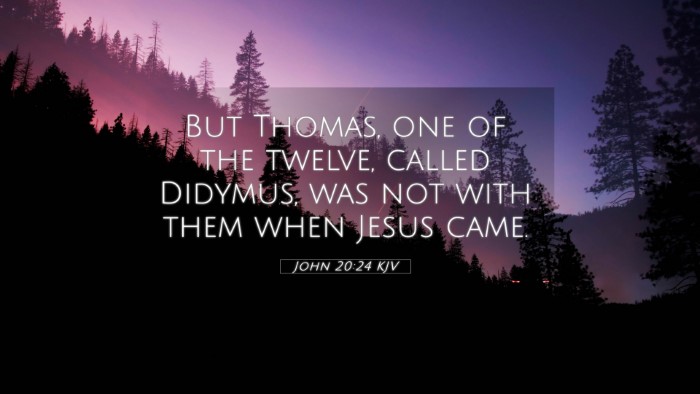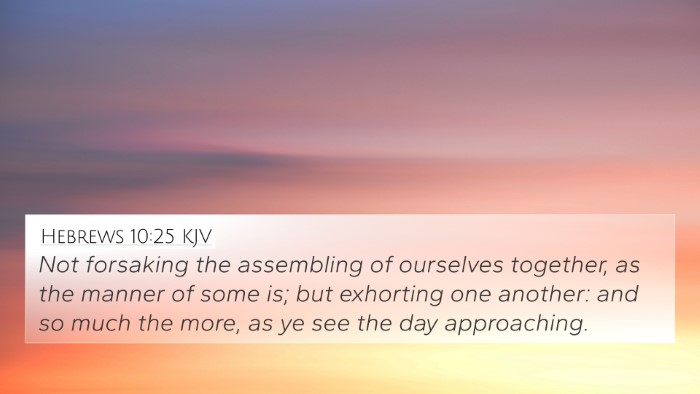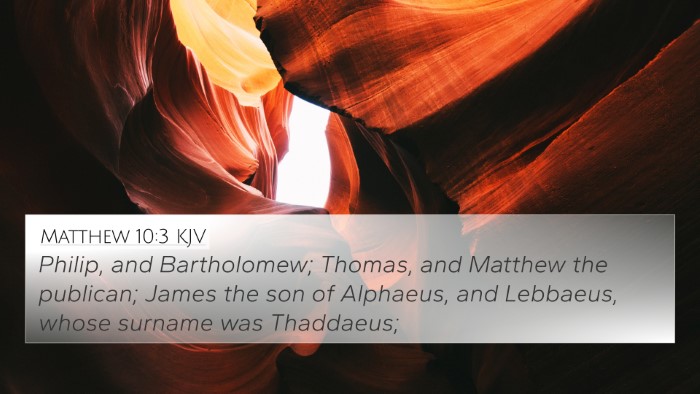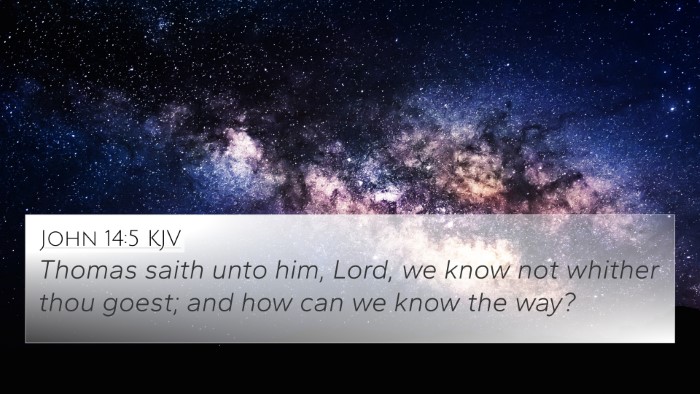Understanding John 20:24
John 20:24 states, "But Thomas, one of the twelve, called Didymus, was not with them when Jesus came." This verse introduces the character of Thomas, highlighting his absence during a pivotal moment of resurrection revelation. Below, we explore the deeper meanings and connections within this verse through insights derived from various public domain commentaries.
Meaning and Interpretation
Matthew Henry's Commentary: Matthew Henry emphasizes the significance of Thomas's absence as a missed opportunity for experiencing the risen Christ. He notes that being away from the community of believers during such a critical event could reflect spiritual isolation. Henry suggests that Thomas's skepticism and subsequent demand for physical proof of Jesus' resurrection illustrate human doubt and the necessity of faith.
Albert Barnes' Notes: Barnes speaks to the identity of Thomas, referencing his dual name, Didymus, and suggests that this reflects his doubting nature. He highlights that Thomas is representative of those who question and require evidence. This passage foreshadows the eventual revelation of Christ to Thomas, which will serve to strengthen his faith and encourage future believers to understand the importance of faith without sight.
Adam Clarke's Commentary: Clarke discusses the context of the disciples' fear and confusion following Christ's crucifixion. He notes that Thomas's absence is curious and suggests that it symbolizes a broader theme of separation from the group during crises. Clarke underscores the transformation that followers can experience through doubt and encourages viewing Thomas’s doubt as a catalyst for deeper faith rather than as mere skepticism.
Cross-References for John 20:24
The verse John 20:24 connects to several other scriptures, forming a network of themes around doubt, belief, and the nature of divine revelation. Here are 10 Bible cross-references related to this verse:
- Matthew 28:17: "And when they saw him, they worshipped him: but some doubted." - This demonstrates that doubt was present even among Jesus' closest followers.
- John 20:25: "The other disciples therefore said unto him, We have seen the Lord. But he said unto them, Except I shall see in his hands the print of the nails, and put my finger into the print of the nails, and thrust my hand into his side, I will not believe." - Directly reflects Thomas's skepticism.
- Hebrews 11:1: "Now faith is the substance of things hoped for, the evidence of things not seen." - A powerful reminder of the nature of faith contrasted with Thomas's need for physical proof.
- Luke 24:36-39: Jesus appears to his disciples, urging them to touch him and see he is risen. This parallels Thomas's doubts and Christ's eventual response.
- Mark 16:14: "Afterward he appeared unto the eleven as they sat at meat, and upbraided them with their unbelief and hardness of heart..." - Illustrates the theme of disbelief among the disciples.
- John 14:6: "Jesus said to him, 'I am the way, the truth, and the life; no one comes to the Father except through Me.'" - Demonstrates the ultimate truth and direction in understanding faith.
- John 11:16: Thomas’s loyalty is revealed when he says, "Let us also go, that we may die with him," demonstrating depth beyond mere doubt.
- 1 Peter 1:8-9: "Whom having not seen, ye love; in whom, though now ye see him not, yet believing, ye rejoice with joy unspeakable..." - Celebrates faith in the unseen.
- James 1:5: "If any of you lack wisdom, let him ask of God, that giveth to all men liberally, and upbraideth not; and it shall be given him." - Encourages questioning and seeking understanding.
- Romans 10:17: "So then faith cometh by hearing, and hearing by the word of God." - Links the development of faith with receiving God's word.
Thematic Connections
This scripture stands as a testament to the human condition of doubt and the longing for certainty in faith. Through cross-referencing Biblical texts, believers can gain deeper insight into both the struggles and the triumphs of faith. The interconnectedness of these verses invites readers to consider the broader biblical narrative surrounding doubt and belief.
Tools for Cross-Referencing
To explore further the connections between Bible verses, various tools are available:
- Bible Concordance: A comprehensive reference to find specific verses and their contexts.
- Bible Cross-Reference Guide: Specific resources designed to help track thematic links across the scriptures.
- Cross-Reference Bible Study: Techniques for studying the Bible with a focus on interrelated passages.
Inter-Biblical Dialogue
Understanding the dialogues between Old and New Testament teachings can enrich one's study of doubt, faith, and revelation. As believers examine links between different parts of scripture, they uncover a deeper understanding of God's message throughout the ages.
Conclusion
In conclusion, John 20:24 invites us to reflect on the nature of faith, the challenges of doubt, and the profound ways in which Jesus meets us in our skepticism. Through the historical accounts in commentaries and the rich tapestry of related scriptures, we are encouraged to seek faith rooted in understanding—even amid uncertainty.
